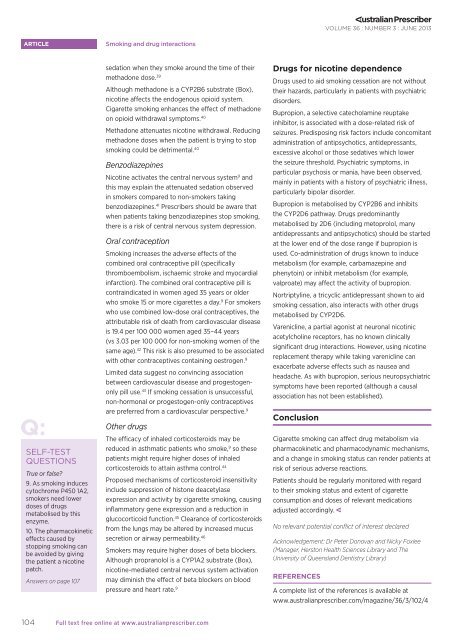download the full PDF issue - Australian Prescriber
download the full PDF issue - Australian Prescriber
download the full PDF issue - Australian Prescriber
You also want an ePaper? Increase the reach of your titles
YUMPU automatically turns print PDFs into web optimized ePapers that Google loves.
VOLUME 36 : NUMBER 3 : JUNE 2013<br />
ARTICLE<br />
Smoking and drug interactions<br />
SELF-TEST<br />
QUESTIONS<br />
True or false<br />
9. As smoking induces<br />
cytochrome P450 1A2,<br />
smokers need lower<br />
doses of drugs<br />
metabolised by this<br />
enzyme.<br />
10. The pharmacokinetic<br />
effects caused by<br />
stopping smoking can<br />
be avoided by giving<br />
<strong>the</strong> patient a nicotine<br />
patch.<br />
Answers on page 107<br />
sedation when <strong>the</strong>y smoke around <strong>the</strong> time of <strong>the</strong>ir<br />
methadone dose. 39<br />
Although methadone is a CYP2B6 substrate (Box),<br />
nicotine affects <strong>the</strong> endogenous opioid system.<br />
Cigarette smoking enhances <strong>the</strong> effect of methadone<br />
on opioid withdrawal symptoms. 40<br />
Methadone attenuates nicotine withdrawal. Reducing<br />
methadone doses when <strong>the</strong> patient is trying to stop<br />
smoking could be detrimental. 40<br />
Benzodiazepines<br />
Nicotine activates <strong>the</strong> central nervous system 9 and<br />
this may explain <strong>the</strong> attenuated sedation observed<br />
in smokers compared to non-smokers taking<br />
benzodiazepines. 41 <strong>Prescriber</strong>s should be aware that<br />
when patients taking benzodiazepines stop smoking,<br />
<strong>the</strong>re is a risk of central nervous system depression.<br />
Oral contraception<br />
Smoking increases <strong>the</strong> adverse effects of <strong>the</strong><br />
combined oral contraceptive pill (specifically<br />
thromboembolism, ischaemic stroke and myocardial<br />
infarction). The combined oral contraceptive pill is<br />
contraindicated in women aged 35 years or older<br />
who smoke 15 or more cigarettes a day. 9 For smokers<br />
who use combined low-dose oral contraceptives, <strong>the</strong><br />
attributable risk of death from cardiovascular disease<br />
is 19.4 per 100 000 women aged 35–44 years<br />
(vs 3.03 per 100 000 for non-smoking women of <strong>the</strong><br />
same age). 42 This risk is also presumed to be associated<br />
with o<strong>the</strong>r contraceptives containing oestrogen. 9<br />
Limited data suggest no convincing association<br />
between cardiovascular disease and progestogenonly<br />
pill use. 43 If smoking cessation is unsuccessful,<br />
non-hormonal or progestogen-only contraceptives<br />
are preferred from a cardiovascular perspective. 9<br />
O<strong>the</strong>r drugs<br />
The efficacy of inhaled corticosteroids may be<br />
reduced in asthmatic patients who smoke, 9 so <strong>the</strong>se<br />
patients might require higher doses of inhaled<br />
corticosteroids to attain asthma control. 44<br />
Proposed mechanisms of corticosteroid insensitivity<br />
include suppression of histone deacetylase<br />
expression and activity by cigarette smoking, causing<br />
inflammatory gene expression and a reduction in<br />
glucocorticoid function. 45 Clearance of corticosteroids<br />
from <strong>the</strong> lungs may be altered by increased mucus<br />
secretion or airway permeability. 46<br />
Smokers may require higher doses of beta blockers.<br />
Although propranolol is a CYP1A2 substrate (Box),<br />
nicotine-mediated central nervous system activation<br />
may diminish <strong>the</strong> effect of beta blockers on blood<br />
pressure and heart rate. 9<br />
Drugs for nicotine dependence<br />
Drugs used to aid smoking cessation are not without<br />
<strong>the</strong>ir hazards, particularly in patients with psychiatric<br />
disorders.<br />
Bupropion, a selective catecholamine reuptake<br />
inhibitor, is associated with a dose-related risk of<br />
seizures. Predisposing risk factors include concomitant<br />
administration of antipsychotics, antidepressants,<br />
excessive alcohol or those sedatives which lower<br />
<strong>the</strong> seizure threshold. Psychiatric symptoms, in<br />
particular psychosis or mania, have been observed,<br />
mainly in patients with a history of psychiatric illness,<br />
particularly bipolar disorder.<br />
Bupropion is metabolised by CYP2B6 and inhibits<br />
<strong>the</strong> CYP2D6 pathway. Drugs predominantly<br />
metabolised by 2D6 (including metoprolol, many<br />
antidepressants and antipsychotics) should be started<br />
at <strong>the</strong> lower end of <strong>the</strong> dose range if bupropion is<br />
used. Co-administration of drugs known to induce<br />
metabolism (for example, carbamazepine and<br />
phenytoin) or inhibit metabolism (for example,<br />
valproate) may affect <strong>the</strong> activity of bupropion.<br />
Nortriptyline, a tricyclic antidepressant shown to aid<br />
smoking cessation, also interacts with o<strong>the</strong>r drugs<br />
metabolised by CYP2D6.<br />
Varenicline, a partial agonist at neuronal nicotinic<br />
acetylcholine receptors, has no known clinically<br />
significant drug interactions. However, using nicotine<br />
replacement <strong>the</strong>rapy while taking varenicline can<br />
exacerbate adverse effects such as nausea and<br />
headache. As with bupropion, serious neuropsychiatric<br />
symptoms have been reported (although a causal<br />
association has not been established).<br />
Conclusion<br />
Cigarette smoking can affect drug metabolism via<br />
pharmacokinetic and pharmacodynamic mechanisms,<br />
and a change in smoking status can render patients at<br />
risk of serious adverse reactions.<br />
Patients should be regularly monitored with regard<br />
to <strong>the</strong>ir smoking status and extent of cigarette<br />
consumption and doses of relevant medications<br />
adjusted accordingly.<br />
No relevant potential conflict of interest declared<br />
Acknowledgement: Dr Peter Donovan and Nicky Foxlee<br />
(Manager, Herston Health Sciences Library and The<br />
University of Queensland Dentistry Library)<br />
REFERENCES<br />
A complete list of <strong>the</strong> references is available at<br />
www.australianprescriber.com/magazine/36/3/102/4<br />
104<br />
Full text free online at www.australianprescriber.com
















